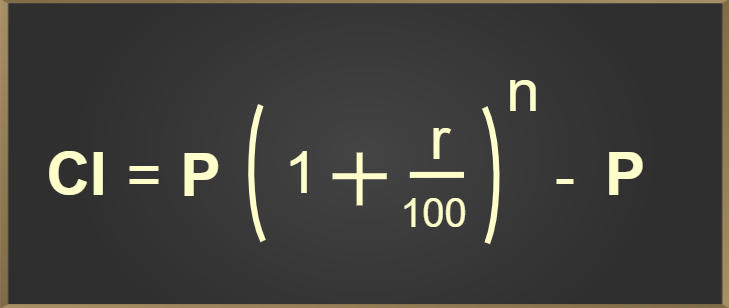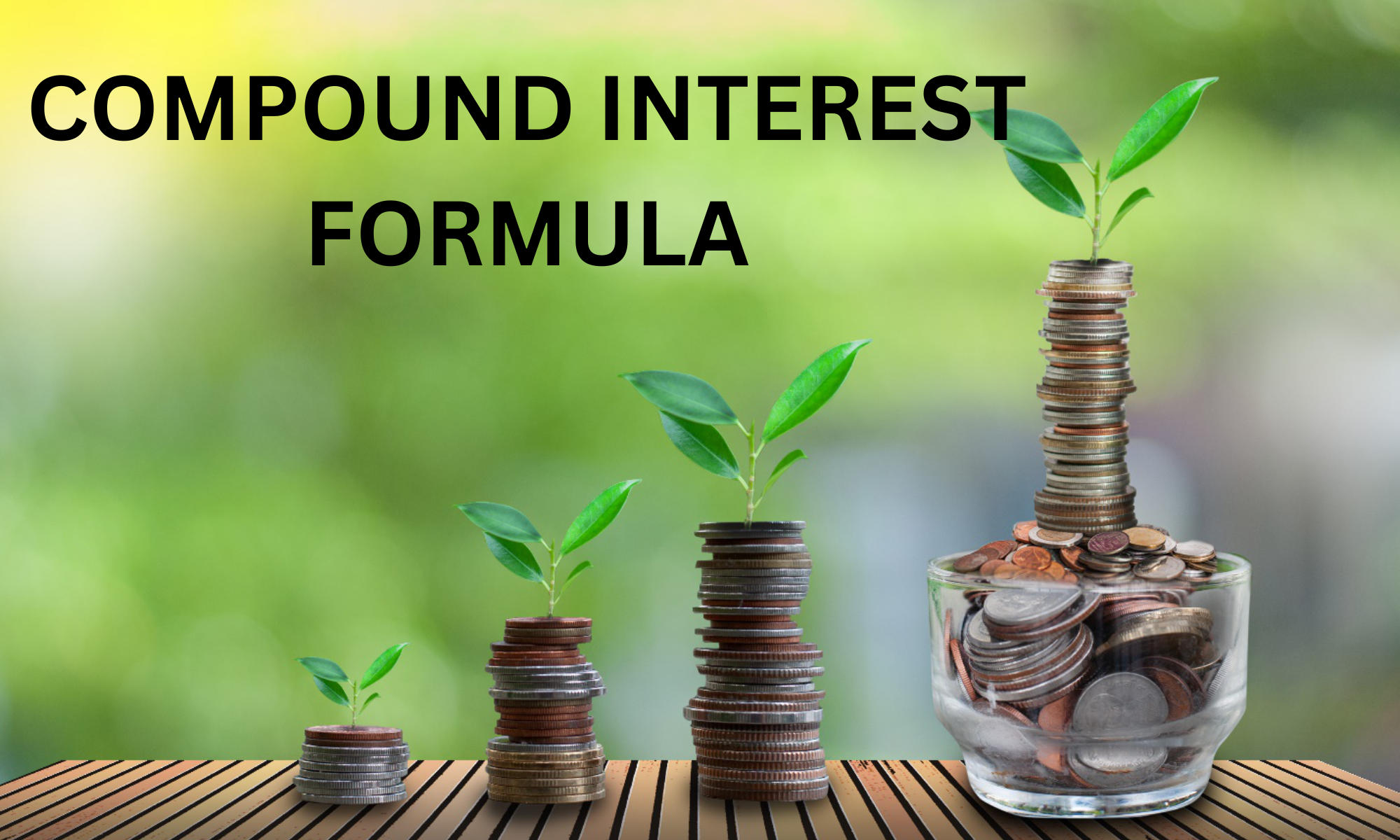Table of Contents
Compound Interest: In contrast to simple interest, which does not compound since past interest is not added to the principal for the current period, compound interest allows interest to build over time. In Compound Interest, the interest per period multiplied by the number of periods in a year yields the simple annual interest rate. The nominal interest rate is another name for the simple annual interest rate.
Compound Interest Definition
Compound interest, also known as interest on principal and interest, is the practise of adding interest to the principal amount of a loan or deposit. Compound interest occurs when interest is reinvested, or added to the loaned capital rather than paid out, or when the borrower is required to pay it, so that interest is earned the following period on the principal amount plus any accumulated interest. In finance and economics, compound interest is common.
The Compound Interest is given by:
Compound Interest = Amount – Principal
Compound Interest Formula
The compound interest formula is a powerful concept in finance, and it is the interest calculated on the initial principal and also on the accumulated interest of previous periods. This results in exponential growth of the investment or debt over time. The formula for calculating compound interest is:
A = P * (1 + r/n)^(n*t)
Where: A = the future value of the investment/loan, including interest P = the principal amount (the initial amount of money) r = the annual interest rate (expressed as a decimal) n = the number of times that interest is compounded per year t = the number of years the money is invested or borrowed for
Let’s break down the compound interest formula step by step:
- P * r/n: This calculates the amount of interest accrued in one compounding period (usually a year) on the principal P. The rate is divided by n since interest is compounded n times per year.
- (1 + r/n)^(nt): This term represents the growth factor of the investment due to compounding. It is calculated by adding 1 to the interest rate (expressed as a decimal) per compounding period (r/n) and raising it to the power of (nt), which represents the total number of compounding periods over the investment’s duration.
- A = P * (1 + r/n)^(n*t): Finally, to get the future value A, we multiply the principal P by the growth factor calculated in the previous step.
It’s essential to use consistent units for the time when using this formula. For example, if the interest rate is an annual rate, then time t should be in years, and n should be the number of times the interest is compounded in one year (e.g., n = 12 for monthly compounding, n = 4 for quarterly compounding).
Let’s look at an example to illustrate how the compound interest formula works:
Example: Suppose you invest $5,000 in a savings account with an annual interest rate of 5%, compounded monthly (n = 12), and you plan to keep the money invested for 3 years (t = 3).
Using the compound interest formula:
A = 5000 * (1 + 0.05/12)^(12*3)
A = 5000 * (1.0041667)^(36)
A ≈ 5000 * 1.1653212
A ≈ $5,826.61
After 3 years, your investment would grow to approximately $5,826.61 with compound interest.
Compound interest is a critical concept to understand when dealing with investments, loans, mortgages, or any financial instruments that involve interest payments over time. It allows your money to grow faster compared to simple interest, where interest is only calculated on the initial principal.

Here,
- CI = Compound Interest
- P = Principal
- r = rate of interest
- n = number of years (‘nt’ if interest is applied t number of times in a year)
Compound Interest Formula in Maths
The total amount of Compound Interest can be calculated by using the following formula for a Periodic Compounding of Compound Interest. The Total amount, which includes the principal sum P and compounded interest I, is calculated by the formula:
where:
- A is the total accumulated amount
- P is the initial principal sum
- r is the interest of the periodic Compound Interest
- n is the annual frequency if compounding of the Compound Interest
- t is the overall length of time for which the compound interest is applied
Compound Interest Formula Questions and Answers
Ques. Find the compound interest (CI) on Rs. 10,000 for 2 years at 15% per annum compounded annually.
Solution:
Given,
Principal (P) = Rs. 10,000
Rate (R) = 15
Number of years (n) = 2
A = P[1 +(R/100)]n
= 10000[1 + (15/100)]2
= 1000[(100 + 15)/100)]2
= 10000 [(115)/100]2
= 10000 × 1.152
= 10000 × 1.3225
= 13225
Total amount, A = Rs. 13,225
Compound interest (CI) = A – P
= Rs. 13,225 – Rs. 10,000
| Compound interest (CI) = Rs. 3,225 — Ans |
Ques. Find the compound interest (CI) on Rs. 10,000 for 2 years at 25% per annum compounded annually.
Solution:
Given,
Principal (P) = Rs. 10,000
Rate (R) = 15
Number of years (n) = 2
A = P[1 +(R/100)]n
= 10000[1 + (25/100)]2
= 1000[(100 + 25)/100)]2
= 10000 [(125)/100]2
= 10000 × 1.252
= 10000 × 1.5625
= 15625
Total amount, A = Rs. 15,625
Compound interest (CI) = A – P
= Rs. 15,625 – Rs. 10,000
| Compound interest (CI) = Rs. 5,625 — Ans |
Compound Interest Formula Examples
- Example 1: Both compound interest and simple interest predict that if you put 1,000 rupees in an account that offers 1% yearly interest, you would receive 10 rupees in interest after a year. However, thanks to compound interest, you will receive 10.10 rupees in interest payments in Year Two, or 1% interest on a sum of 1,010 rupees (principal plus interest).
- Example 2: Both corporate and governmental bond interest is typically due twice a year. The stated interest rate is divided by two, the principle is multiplied, and the result is the amount of interest paid (every six months). The disclosed rate is lower than the annual compounded rate.
- Example 3: When valuing derivatives, for instance, continuous compounding, which is the maximum as the compounding period approaches 0, is sometimes theoretically simpler. Continuous compounding of these instruments’ prices is an inevitable result of Ito calculus.
Compound Interest Formula QNAs
What is compound interest for example?
Compound interest, is also known as interest on principal and interest. Compound interest and simple interest both predict that after a year, a deposit of 1,000 rupees at 1% annual interest will yield 10 rupees in interest. However, due to compound interest, you will receive 10.10 rupees in interest payments for the year if you earn 1% interest on 1,010 rupees in Year Two (i.e., the principal plus the interest).
What is 6% compounded monthly calculated with the compound interest formula?
Because of this, lenders frequently prefer to advertise interest rates that are compounded monthly rather than annually. For instance, a monthly interest rate of 0.5% is equal to a mortgage interest rate of 6%. However, interest amounts to 6.17% yearly compounded after compounding on a monthly basis.
What is 12% compounded monthly calculated with the compound interest formula?
A monthly interest rate of 12% interest means that the interest rate is 12% annually (which is not to be understood as 12% monthly). As a result, the monthly interest rate is 1% (12% / 12).
What are the 3 types of compound interest?
The formula for Monthly Compound Interest. 12 times a year are used to calculate the interest that is compounded monthly. The formula for Quarterly Compounding. Four times a year are used to calculate the interest that is compounded quarterly. The formula for annual compound interest is used once a year.



 PSEB 12th Result 2024 Date, Punjab Board...
PSEB 12th Result 2024 Date, Punjab Board...
 APOSS Inter Results 2024 Out, AP Open Sc...
APOSS Inter Results 2024 Out, AP Open Sc...
 Karnataka SSLC Exam Result 2024 Date, Wh...
Karnataka SSLC Exam Result 2024 Date, Wh...















